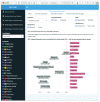An interactive application for malaria elimination transmission and costing in the Asia-Pacific
- PMID: 31984239
- PMCID: PMC6971843
- DOI: 10.12688/wellcomeopenres.14770.2
An interactive application for malaria elimination transmission and costing in the Asia-Pacific
Abstract
Leaders in the Asia-Pacific have endorsed an ambitious target to eliminate malaria in the region by 2030. The emergence and spread of artemisinin drug resistance in the Greater Mekong Subregion makes elimination urgent and strategic for the global goal of malaria eradication. Mathematical modelling is a useful tool for assessing and comparing different elimination strategies and scenarios to inform policymakers. Mathematical models are especially relevant in this context because of the wide heterogeneity of regional, country and local settings, which means that different strategies are needed to eliminate malaria. However, models and their predictions can be seen as highly technical, limiting their use for decision making. Simplified applications of models are needed to allow policy makers to benefit from these valuable tools. This paper describes a method for communicating complex model results with a user-friendly and intuitive framework. Using open-source technologies, we designed and developed an interactive application to disseminate the modelling results for malaria elimination. The design was iteratively improved while the application was being piloted and extensively tested by a diverse range of researchers and decision makers. This application allows several target audiences to explore, navigate and visualise complex datasets and models generated in the context of malaria elimination. It allows widespread access, use of and interpretation of models, generated at great effort and expense as well as enabling them to remain relevant for a longer period of time. It has long been acknowledged that scientific results need to be repackaged for larger audiences. We demonstrate that modellers can include applications as part of the dissemination strategy of their findings. We highlight that there is a need for additional research in order to provide guidelines and direction for designing and developing effective applications for disseminating models.
Keywords: Asia-Pacific; Elimination; GMS; Interactive application; Malaria; Model-based Decision Support System; Modeling; Modelling.
Copyright: © 2019 Celhay OJ et al.
Conflict of interest statement
No competing interests were disclosed.
Figures




References
-
- APLMA Roadmap. Reference Source
-
- WHO World Malaria Reports. Reference Source
Grants and funding
LinkOut - more resources
Full Text Sources

